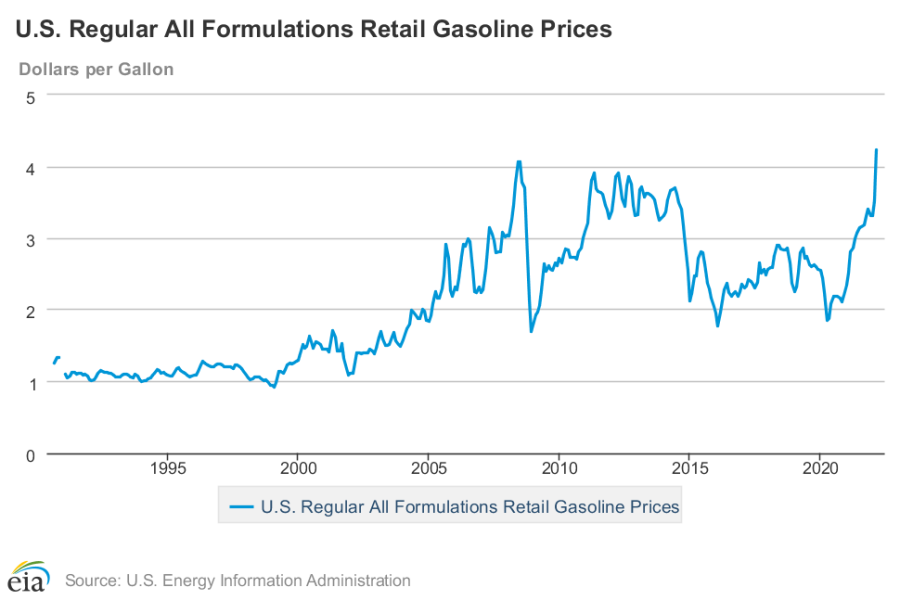Biden Struggles to Balance Environmental Concerns and Oil Prices
The Biden administration faces yet another challenge to its agenda, this time from within its own faction. After several months of extremely high gas prices and the backlash that has come with it, President Biden has feverishly fought to bring prices down – going so far as to release nearly a million barrels of oil per day to bring down gas prices – but in emphasizing oil prices, Biden now faces serious questions about his ability to enact a strong climate plan in a country that is heavily dependent on oil and gas for transportation.
Why are gas prices so high?
The issue of gas prices is a source of complex, bitter and partisan discourse. Republicans have consistently blamed President Biden for the rise in gas prices, with some pointing to the decision to shut down the Keystone Pipeline as a contributing factor. Senate Minority Leader Kevin McCarthy has previously pointed to the Keystone Pipeline as an example in a speech, saying, “… The president canceled the Keystone pipeline, and then he stopped new oil and gas leases on federal lands and waters.”
Others, however, have pointed to a wide variety of factors influencing gas prices. Everything from Russia, inflation, and global oil prices have been brought up. The UIS Observer’s own Jermaine Windham has done dives into those same factors in an excellent piece early this month. That said, much of the conversation surrounding gas prices is hyper-focused on individual presidents and not on the larger context in which their policies exist.
Rarely, if ever, is there any consideration about the limitations of a president’s agency in affecting oil prices in an increasingly global and interconnected world. One example of this is the lackluster attention directed at the Organization of Petroleum Exporting Countries, more commonly known as OPEC. OPEC, a collection of 13 countries that produce oil, is a massive part of the global oil supply chain. Its share of the global crude oil supply is approximately 37%, making this collection of nations one of the largest producers in the world.
When the pandemic began to take hold, people were isolated in their homes, and crude oil prices dropped significantly, causing OPEC and other oil producers to cut production to prevent them from losing their profit margins. By April 2020, gas prices dropped to levels not seen since 2016 before shooting back up in August of that same year.

As a result, supply has not kept up with the demand, which Biden has tried to address by increasing the amount of oil in American markets. Even though the U.S. is the nation that produces the most oil, it is still subject to global oil prices.
How does this affect the environment?
With the rise in oil prices globally, Biden faces immense pressure to expand America’s ability to produce oil at lower prices, especially with the midterms coming up. That said, Biden also risks undermining his promises to uphold a stronger climate agenda.
With the failure of the Build Back Better act to pass the Senate, Biden’s climate plan is already on thin ice. However, Biden has shown some willingness to enforce and restore protections for the environment. In April of this year, he reversed former President Trump’s decision to remove requirements that government agencies consider environmental impacts when examining infrastructure.
The impetus to reduce gas prices and increase supply has led Biden to allow oil companies to restore onshore, and gas leases on federal land, albeit with a higher fee. This was somewhat motivated by the Department of the Interior recommending that the federal government increase fees for oil and gas to give a greater return to the taxpayer.
Biden’s policies will inevitably result in more carbon dioxide being released into the atmosphere by releasing oil from their reserves, restoring gas and oil leases, and working to allow more oil to be used. Normally, E15 gasoline, which is a gas that contains 15 percent ethanol, is banned during the summer to avoid damaging the country’s air quality. Earlier this month, Biden announced that the ban would be waived for the coming summer, pointing to gas prices as the justification. In a speech explaining his speech, Biden stated:
“E15 is about 10 cents per gallon cheaper than E10. Some gas stations offer an even bigger discount than that…But many of the gas stations that sell it … are required to stop selling it in the summer, but with this waiver, on June 1, you’re not going to show up and see a bag over the pump with the cheapest gas. You’re going to be able to keep filling up with E15, and it’s going to solve a whole problem.”
Despite referring to climate change as an existential threat last year, the reality of gas prices and the combined pressure from fossil fuel interests in the upcoming election are seemingly guiding Biden to balance two agendas to please both.
In other words, Biden is stuck between a rock and a hard place. He cannot appeal to the need for strong climate change policies and simultaneously respond to rising oil prices by making oil flow and environmental activists know it. So long as Biden responds to the current oil crises without the infrastructure necessary to wane America off of gas, his administration will continue to struggle against these two factions of energy politics.













